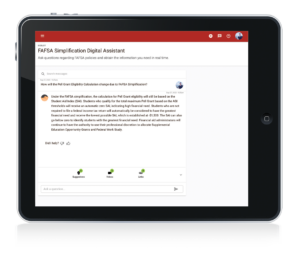For many students, getting the money to pay for college means the difference between enrolling or not, between earning a credential that can lead to higher wages and financial security for their families, or stopping out. Therefore, effective communication about financial aid eligibility and processes is critical to the success of institutions’ enrollment and retention initiatives.
Financial aid staff play a pivotal role in helping students navigate the complex and often stressful terrain of college financing to achieve their educational goals. These professionals spend a significant amount of their time every day communicating with students and families through a variety of avenues — phone calls, emails, presentations, walk-ins, and more — with the goal of breaking confusing processes (and thousands of pages of federal regulations) down to achievable steps in order to receive aid.
I joined the AI team at Ocelot after spending nearly a decade working in financial aid offices at a variety of colleges and universities because I experienced firsthand the challenges of providing personalized support to hundreds (or thousands) of students while staying on top of emerging trends and the ever-evolving financial aid landscape.
Ocelot’s AI-powered Student Communication Platform includes solutions like Chatbot, Two-Way texting, and Live Chat that are invaluable tools for easing the burden on financial aid staff while making student communication more efficient and proactive. All of that being said…
The Most Important Communication Financial Aid Departments Will Send This Year Is…
… About FAFSA Simplification! It’s no secret that FAFSA Simplification is the buzzword on the lips of every administrator — and if it isn’t, it should be. The FAFSA Simplification Act is the biggest shakeup in Federal student financial aid in decades, with far-reaching ramifications for any organization that awards money to college students.
From changing the way aid eligibility is calculated to the launch date of the FAFSA itself, FAFSA Simplification is bringing fundamental changes to many once-familiar parts of the financial aid process. Wondering how you can face the challenge of FAFSA Simplification and keep students, parents, and employees in the loop? I’ve got some suggestions for you!
3 Ways You Can Prepare for FAFSA Simplification
1. Update Your Knowledge Base, Communications, and Other Assets
One of the first steps your office should take in preparing for FAFSA Simplification is to ensure all student-facing materials — from the notifications, letters, and emails you send out, to any presentations or print materials you share at financial aid nights, to your chatbot’s knowledge base — are up-to-date with these changes.
Providing students and families with accurate and timely communication about their aid is key to a positive customer experience and student success. And regulatory compliance is key to running a successful aid office (and getting a clean A-133).
2. Help Staff With Training and Resources
FAFSA Simplification brings changes to the financial aid process for students and financial aid professionals. Current students and seasoned staff who have become accustomed to a FAFSA that goes live on October 1st and uses an EFC to determine eligibility will need to learn new terms like Student Aid Index (SAI) and new eligibility criteria. And the US Department of Education has announced that the 2024-2025 FAFSA won’t be available for students to complete until December 2023 (exact date TBD), significantly shortening the traditional awarding cycle and potentially leaving schools scrambling to communicate with students.
Staying informed and adapting to these changes is crucial to financial aid professionals and the students who rely on them for information and assistance. That’s where Ocelot’s FAFSA Simplification Digital Assistant comes into play. Specifically designed for financial aid and enrollment teams, the digital assistant offers a user-friendly and interactive space to help you and your team get up to speed with FAFSA Simplification. It serves as a knowledge base and a training tool, ensuring that your staff is prepared to confidently handle the new financial aid landscape, remain in compliance with federal regulations, and provide top-notch counseling to students.
3. Text Your Students About the Biggest Changes
When it comes to communicating effectively with students, proactivity is the name of the game. Get ahead of student questions by sending out a carefully-crafted text campaign about the significant changes coming to the FAFSA, the way their financial aid eligibility is calculated, and the awarding timeline itself. Ocelot’s Two-Way Texting solution with in the AI-powered Student Communication Platform offers schools the opportunity to proactively engage students by delivering critically important information through a channel most of them check multiple times each day.
An effective FAFSA Simplification communication strategy will include several touchpoints delivered across the financial aid cycle to keep your students informed and on the right track without overwhelming them. Our template library includes dozens of additional brief messages about FAFSA Simplification customized for different student populations, and offers the option to respond to student questions with Ocelot’s AI Chatbot or a human staff member.
Conclusion
Timely and accurate financial aid communication is vital to the success of students and the institutions they attend. FAFSA Simplification introduces major changes to a decades-old process that, despite its complexities, has become familiar to many, making this communication even more critical. The content and delivery of messaging around FAFSA Simplification should be a central theme in your financial aid office’s communication strategy this year. By updating your knowledge base, sending proactive messages, and utilizing resources like Ocelot’s FAFSA Simplification Digital Assistant, we can ensure that students and institutions alike are well-prepared to navigate the evolving financial aid landscape.
















